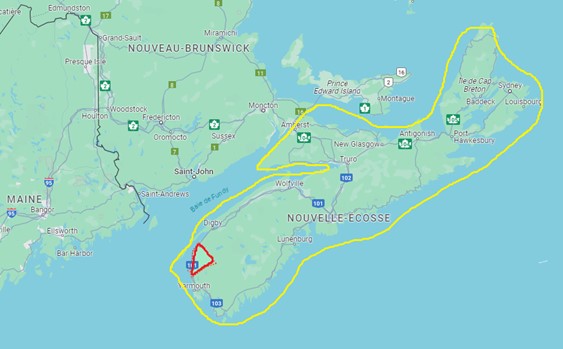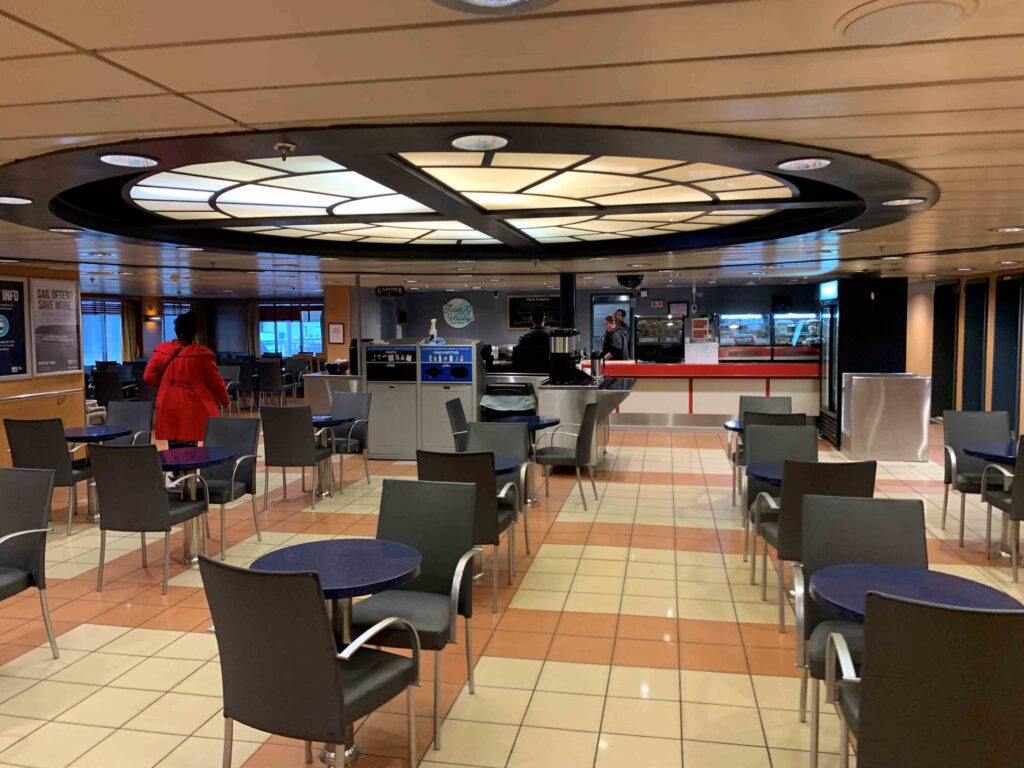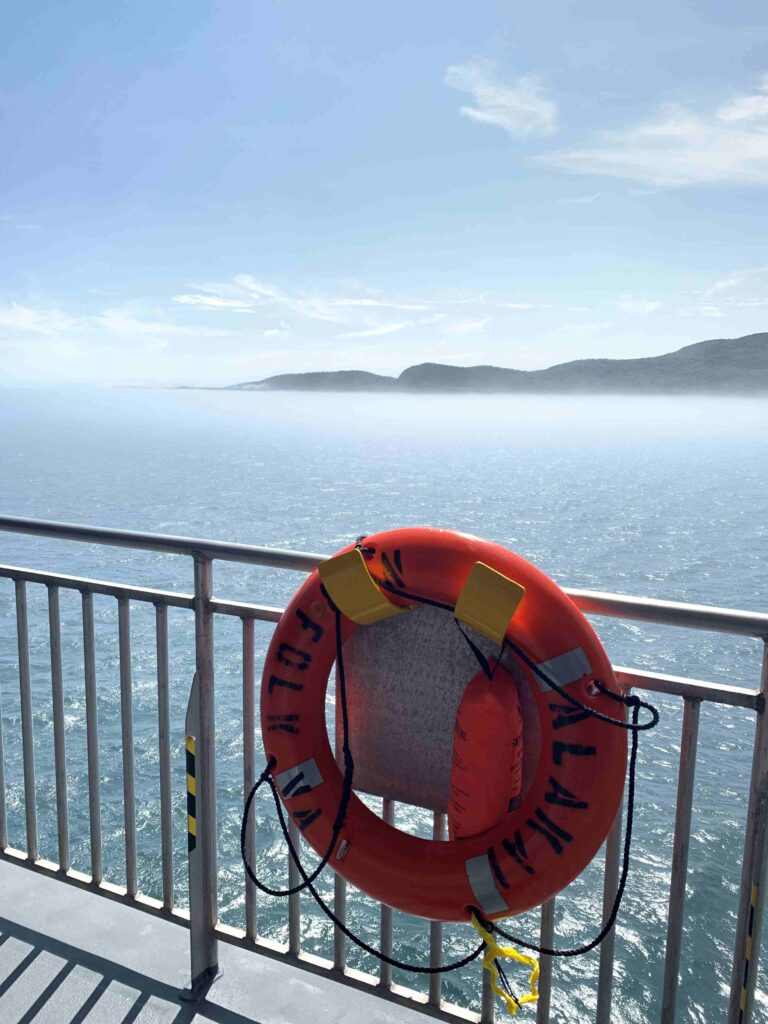
How to travel to Clare (Baie Sainte-Marie area), Nova Scotia
If you’re visiting us from another province or northeast USA, you may be wondering how to travel to Clare and the Baie Sainte-Marie area in the Acadian Shores region of Nova Scotia. Here’s an overview of the options available.
Where is the Clare/Baie Sainte-Marie area?
Baie Sainte-Marie is the name given to the Acadian region bordering St. Mary’s bay in southwest Nova Scotia, on the Bay of Fundy side. Locally known as the “French Shore”, it refers to the Municipality of Clare.
Many people think that Nova Scotia is an island, but it’s actually a peninsula – the province is mostly surrounded by water, but it shares a land border with New Brunswick.

Nova Scotia is circled in yellow, and the municipality of Clare (also known as the Baie Sainte-Marie area) is outlined in red.
You can travel to Clare :
- by plane (Halifax airport is a 3-hour drive away);
- by car only (by driving around the Bay of Fundy);
- by car and ferry (there is a ferry from Saint-John, New Brunswick to Digby, Nova Scotia, and a ferry from Bar Harbor, Maine to Yarmouth, Nova Scotia).
By plane
The Halifax airport is a 3-hour drive from Clare. If you choose to fly into Nova Scotia, you’ll need to rent a car. Make sure you book a car as soon as you get your plane tickets, because since COVID, there’s often a shortage of rental cars at the Halifax airport, especially in high season.
By car
To drive to Clare, there are three options. To give you an idea of how long it can take, I’ll use Montreal as my point of departure and our cottage La Bluefin, located in Meteghan in the heart of Clare, as my point of arrival.
- Blue route: Driving around the Bay of Fundy and passing near Moncton and Halifax. From Montreal, it’s about a 15-hour drive, not counting stops.
- Yellow route: Taking the Fundy Rose ferry from St-John, New Brunswick to Digby, Nova Scotia. From Montreal, it’s about a 9-hour drive to St-John. You’ll need to arrive at the ferry one hour early. The crossing takes about 2h15, and La Bluefin is 45 minutes away from Digby.
- Red route: Taking the CAT ferry from Bar Harbor, Maine to Yarmouth, Nova Scotia. From Montreal, it’s about a 6.5-hour drive to Bar Harbor (not counting customs). You’ll need to arrive at the ferry one hour early. The crossing takes 3h30, and then you have to go through customs again. La Bluefin is 30 minutes away from Yarmouth.

Advantages et disadvantages of each route
Driving around the Bay of Fundy
- No scheduling constraints
- Long
Driving around is long (about 15 hours from Montreal, not counting stops). On the other hand, the fact that you’re not tied to a specific ferry departure time is an advantage. In our opinion, it’s also the best option if you’re planning to visit Halifax, Peggy’s Cove or Lunenburg, as you’ll be able to stop there “on the way”.
Ferry from New Brunswick to Nova Scotia
- Less driving
- Experience on board
- Stability of the boat
- Cost
- Schedule on the way to Nova Scotia

The Fundy Rose ferry connects Saint John, New Brunswick, and Digby, Nova Scotia. It operates year-round, except during periods when it is dry-docked for maintenance (usually in the spring).
Less driving: Compared to driving around the Bay of Fundy, the ferry saves time, but mostly a lot of driving. It takes about 9 hours to get to St-John’s from Montreal, and you should plan to arrive at the ferry one hour before departure time (*note that the schedule is based on Atlantic time, so you “lose” an hour if you’re travelling from an area on Eastern Time). The drive from Montreal is easy, as it’s almost all highway. The crossing between Saint-John and Digby takes about 2h15, and La Bluefin is 45 minutes away from Digby. In our case, it takes about 13 hours in total. Even though the ferry save us “only” 2-3 hours compared with driving the long way, we arrive less tired – we can sleep, read or relax on the boat, and we don’t have to be as alert as when we’re driving.
Experience on board: The onboard experience is enjoyable – there’s a small cafeteria and a gift store, two movies are featured, you can stay inside or go out on deck to enjoy the salty air (bring a good sweater or even a coat, it’s never very warm on the Bay of Fundy!) and, on some summer sailings, you can attend performances by local artists or short presentations on the Bay of Fundy and its tides or marine mammals.
Stability of the boat: The ferry is very stable. I’m prone to seasickness and I don’t feel the boat rocking. In winter, in high winds, it moves a bit more, but in summer I’ve never taken Gravol and it’s always been fine.
Cost: There’s obviously a cost associated with taking the ferry, but since it saves 500 km of driving and gas, it’s an interesting option. It’s also less expensive than the Maine ferry, and the fares are in Canadian dollars. For us, arriving at the boat feels like the start of our vacation. And since we can nap on the ferry, we are not as tired when we get to Meteghan than when we take the long way around.
Schedule: The schedule is the main drawback. The crossing to Nova Scotia is in the morning, and during the high season there’s a second one in the early afternoon. This means that, depending on where you leave from, you’ll have to drive during the night or stop overnight to arrive on time. The schedule is better for the return trip: the crossing from Nova Scotia to New Brunswick is in the late afternoon but in high season there’s also one in the late morning, which allows you to return during the day (in our case, we’re back in the Montreal area by 10 p.m.).
Weather can be a factor, but it has to be very windy for the ferry to be cancelled. In summer, we’ve only seen cancellations during hurricanes. In winter, the seas are much rougher and some crossings may be cancelled, but this is usually announced on the Bay Ferries website or Facebook page 24 hours in advance.
Good to know: Reservations are strongly recommended. You can book online if you are more than 24h in advance (the day before, you have to call). You can cancel with a full refund up to 24h before the crossing. Dogs are allowed on board free of charge, but must remain in the car. Approximate cost for 2 people and 1 vehicle: $227 CAD before fees and taxes.



Ferry from Maine to Nova Scotia
- Most direct route
- Schedule
- Cost
- Seasickness
- Customs

The CAT ferry connects Bar Harbor, Maine, and Yarmouth, Nova Scotia. The CAT is a seasonal ferry, usually operating from late May to early October.
Most direct route: Taking the CAT is the most direct and shortest route from Montreal (about 6h30-7h). Getting there, however, involves country roads with frequent changes of direction and speed limits. Unless you know the area well, you’ll need a GPS. You’ll also need to clear customs to enter the U.S. (and comply with the new requirements for crossing the border with a dog if you’re traveling with your furry friend).
Schedule: The CAT ferry schedule is ideal – it leaves Nova Scotia in the morning and Maine in the late afternoon, making the Montreal-Maine or Maine-Montreal route possible during daylight hours (no need to drive at night or stop overnight along the way).
Cost: The fares are high and in US dollars. There are occasional promotions and special offers, but even with discounts, it’s still more expensive than the Fundy Rose.
Seasickness: I don’t know if it’s because it’s a catamaran, but this ferry rocks a lot. The day we took it, the sea was very calm. Yet few people on board could walk in a straight line. If you’re seasick, I wouldn’t recommend it (I had been warned and had taken Gravol. I didn’t feel nauseous, but I was walking in a zigzag pattern and felt the rocking of the boat a lot. The Fundy Rose, even in rough winter seas, doesn’t sway as much – in summer I can hardly feel anything and I don’t need to take seasickness medication).
Customs: If you’re travelling from Canada, you’ll need to clear customs twice: when you enter the USA by car and when you get off the boat in Yarmouth. You’ll need to comply with the rules that apply when crossing the border. If you’re travelling from the USA, obviously you’ll only go through customs in Yarmouth. The wait when you get off the boat can be surprisingly long – even though we were among the first ones out, the terminal staff lined up the vehicles in several lines but only opened two customs booths. We waited 45 minutes. What little time we had gained compared to taking the other ferry in New Brunswick was lost.
Good to know: As with the Fundy Rose, reservations are strongly recommended. You can cancel with a full refund up to 24 hours before the crossing. Dogs are allowed on board free of charge, but must remain in the car. Approximate cost for 2 adults and 1 car: $429 USD before fees and taxes.



Our recommendation
For us departing from Montreal and going directly to Meteghan, in southwestern Nova Scotia, our preference is by far to take the Fundy Rose ferry from New Brunswick.
That said, if you want to go to the Atlantic side of the province and visit Halifax, Peggy’s Cove or Lunenburg, we advise you to take the long way around and plan to go there “on the way”. Our guests who went to the South Shore/Halifax area as a daytrip from La Bluefin told us that it was a very long drive and an overall exhausting day (Peggy’s Cove is 3.5 hours away, so 7 hours of travel in total). For an optimal itinerary, since the ferry schedule is more advantageous on the return trip, consider going to Halifax before coming to La Bluefin. It’s about 13 hours from Montreal. Book two nights in Halifax or on the South Shore, and you’ll have a full day to visit the city and its surroundings. The next morning, you can head to the Bay of Fundy side of the province and make stops in the Annapolis Valley on the way to La Bluefin, for example at the Grand-Pré historic site to learn more about the history of the Acadians and the Deportation, or at one of the many wineries in the area for lunch or a tasting. At the end of your stay in Baie Sainte-Marie, take the shortcut across the Bay of Fundy on the Fundy Rose ferry to New Brunswick for a quicker return home.
For more information on ferries, visit the Bay Ferries website. And don’t hesitate to contact us if you need help planning your itinerary!

Looking for an oceanfront vacation rental in Clare, Nova Scotia?
La Bluefin is a cottage located in Meteghan, in the heart of Clare and the Baie Sainte-Marie area in the Acadian Shores region of southwest Nova Scotia. Built on a cliff overlooking the Bay of Fundy, it offers breathtaking 180-degree ocean views with sunsets on the water.
